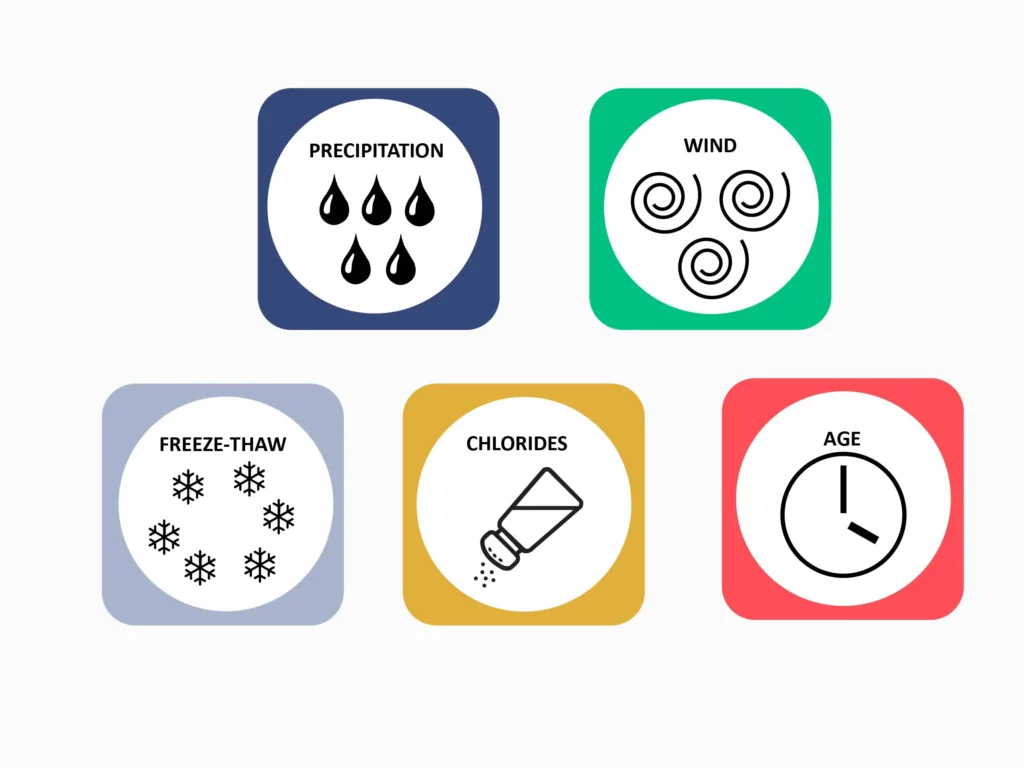Natural elements are an unavoidable element of façade management. Weather behaviors will be an obstacle to a sound building enclosure, but with the proper planning, can be managed appropriately. Here are five common weather patterns that affect building façade management.
Rain Damage
Moisture penetration is the number one cause for building envelope failure. Precipitation is the chief mechanism by which water finds its way into the facades of buildings. Water seeps into the tiny pores and crevices, causing damage. Moisture can erode masonry, disintegrate mortar and open up flashings just to list some of the effects. Water may linger in the drainage plain or wet exterior cladding. The ultimate result of this is a weakened façade that shortens the time between repairs and expensive restoration.
Freeze-Thaw
Freeze-thaw is the process of water expanding when frozen and melting to fill the space. This harms the building façade because it weakens the integrity of materials. The temperature swings accelerate the mortar deterioration process which in turn allows more water to enter the façade, causing a destructive cycle. Sealants and flashings can also be deteriorated. This results in movement and shifting that could cause falling materials or structural damage.
Chloride deterioration
Chloride deterioration is more of a man-made response to the weather but nonetheless poses a threat to the integrity of facades and parking structures. Road and sidewalk salt are common solutions to icy winters in cold parts of the country. These chlorides get picked up by people’s shoes and vehicles and deposited in and around entrances as well as parking garages. Chlorides can deteriorate building materials at entrances as well as corrode reinforcement within a parking garage structure.
Wind / Storm Damage
Strong winds can be another threat to building façades. They can break down bricks or exterior claddings. Missiles can be picked up by particularly strong winds and chip away at the façade or fenestrations. Intense winds can widen existing cracks from rain or frost.
Wind currents can affect the building from any direction and put different kinds of pressure on the external walls and materials. Facilities can experience both positive (a push) and negative pressure (a suction) at the same time. The pressure is multiplied by the velocity of the wind, and with taller buildings, wind moves much faster at higher elevations. Wind can also have an effect on the interior of the building, either increasing or decreasing the pressure, resulting in changes to the façade’s porosity. The Whole Building Design Guide by the National Institute of Building Sciences provides a more in-depth analysis of wind effects on the entire building enclosure.
Age
Like everything in life, the façade of your building has a lifespan. The materials will not last forever, requiring repairs and/or replacement. Over years of wear and tear, forces like the above may disrupt the design’s efficacy. Entryways will develop for moisture and air to infiltrate the building enclosure. In short, time is the unavoidable threat. Proper preventative maintenance extends the life of a façade system by catching issues when they are small and easy to fix. Lack of maintenance will accelerate the deterioration process, often resulting in more expensive restoration projects. Age will always be a factor in calculating the overall condition of the building envelope, but with the proper partner it can be managed with ease.
Technical Assurance specializes in façade management consulting. We know how to identify areas of concern and can provide expert recommendations on how to get the most out of your building assets.
For more information on how Technical Assurance can solve your unique façade-based challenges, connect with us today.

